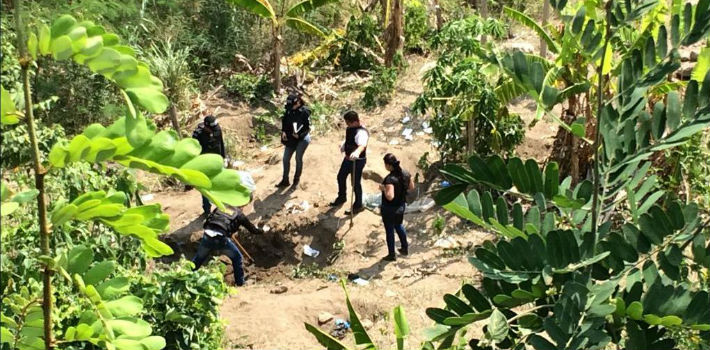
EspañolOn Tuesday, May 5, Venezuelan soldiers discovered 12 corpses in two mass graves in Ureña, Táchira State, in western Venezuela near the border with Colombia. Each of the bodies appears to have been executed with a gunshot to the back of the head.
The area was subsequently flooded with military units tasked with investigating the deaths and locating those responsible. The find followed a tip-off from a presumed member of a Colombian paramilitary group, who was captured and confessed knowledge of multiple homicides committed in late 2014 by criminal groups in the region.
The same individual also informed security forces of the identity of some of those buried in the graves, among them presumed Colombian paramilitary fighters under the aliases Sandra, La Pájara, El Wicho, and El Antiguo.
State Governor José Vielma Mora told press that the deaths were due to an ongoing battle between criminal groups engaged in drug trafficking and the smuggling of petrol and food to Colombia, suggesting that some of those killed were Colombian citizens. On Thursday, it emerged that Colombian investigators will join a Venezuelan forensic team in examining the remains.
The exact site of the graves is known as Los Tanques, near the village of La Mulata, in Pedro María Ureña district. A road nearby crosses the border to San Faustino, in Colombia’s Norte de Santander department, known as a center of operations for criminal groups, including Marxist guerrilla group FARC.
“It’s a hot zone, where the guerrilla and the paramilitaries operate … there are constant clashes and murders due to the diverse activities on the border, stemming from rivalry over the control of the zone, like contraband smuggling, drug trafficking, extortion, and other crimes,” said a Venezuelan official, who preferred to remain unnamed.
Unofficial reports circulated that the person responsible for the killings was the commander of Colombian paramilitary group Los Urabeños known as Comandante Cara de Niño (“Commander Babyface”).
The Public Ministry of Venezuela has meanwhile commissioned prosecutors Grendy Duque, Marelvis Mejía, and María Arthaona, all from the state of Táchira, to investigate the case.
Criminal Haven
Venezuela and Colombia share a porous border of 2,200 kilometers, which provides a safe haven for criminal groups, smugglers, and armed movements. Among the better-known paramilitaries in the area are Los Rastrojos and Los Urabeños, groups originally created to combat the FARC.
Lorena Arraíz, a Táchira State correspondent for Venezuelan daily El Universal, told the PanAm Post that despite the Venezuelan border technically being under the control of the army and the Bolivarian National Guard (GNB), criminal groups “are really in charge.”
“It’s a very complex and dangerous situation,” she added, describing the roots of the problem as social and political exclusion which the government should tackle “as soon as possible.”
Arraíz described how rival guerrilla, paramilitary, and criminal groups openly operate in the area for control of petrol, food, drugs, and mineral resources, each headed by a clear command structure. Despite many journalists in the area giving detailed evidence over the individuals and locations involved, she added, the Venezuelan authorities were “very slow in addressing this problem.”
For example, a radio station in Táchira belonging to Colombian rebel group the National Liberation Army (ELN) continues to be on the air, despite reporters demanding that state telecoms agency Conatel cut off the frequency.
The El Universal reporter added that border authorities were at the mercy of the pimpineros, groups smuggling gasoline in containers between the two countries. Whenever the borders are partially closed, the smugglers allegedly commit acts of violence and force businesses to shut down. Arraíz reported that neither the army, GNB, nor the police would come to restore order because “the pimpineros are those who command the zone.”
Despite the flagrant activities of groups “operating, commanding, extorting, blackmailing, and murdering” on both sides of the border, Arraíz lamented that the government “doesn’t do anything.”
She further cited the example of how, after the leader of the local teachers’ union delivered proof to the governor that the ELN was issuing a propaganda magazine to schools, the authorities did “absolutely nothing.”
Army Inactivity
While the military authorities reportedly overlook the criminal activity going on under their very noses, the soldiers seem content with holding up civilians in lengthy border queues.
Arraíz said that she travels at least once a month to Cúcuta, Colombia, to buy food that she cannot find in Venezuela. In order to the make the journey, she has to cross all of Táchira State capital San Cristobal. This leg of the journey should only take 10 minutes, but instead the journalist routinely spends four hours in line at five separate army and GNB checkpoints.

“If they consider that my vehicle has too much petrol to go and come back, they can extract it, because they think I’m going to resell it in Colombia,” she told the PanAm Post. “It’s a reality that all of us who travel between Cúcuta and Táchira have to live with.”
Despite the Venezuelan government previously promising that 17,000 soldiers would be posted to the border to “eliminate contraband,” the flow of illegal goods appears to be unaffected, raising questions about the reliability of the armed forces and the authorities.
“It’s incomprehensible that these things are happening before the eyes of the military and with the knowledge of the government,” Arraíz said, wondering: “Is it that both are accomplices to the criminals?”
Translated by Amanda Blohm. Edited by Laurie Blair.
 Versión Español
Versión Español













